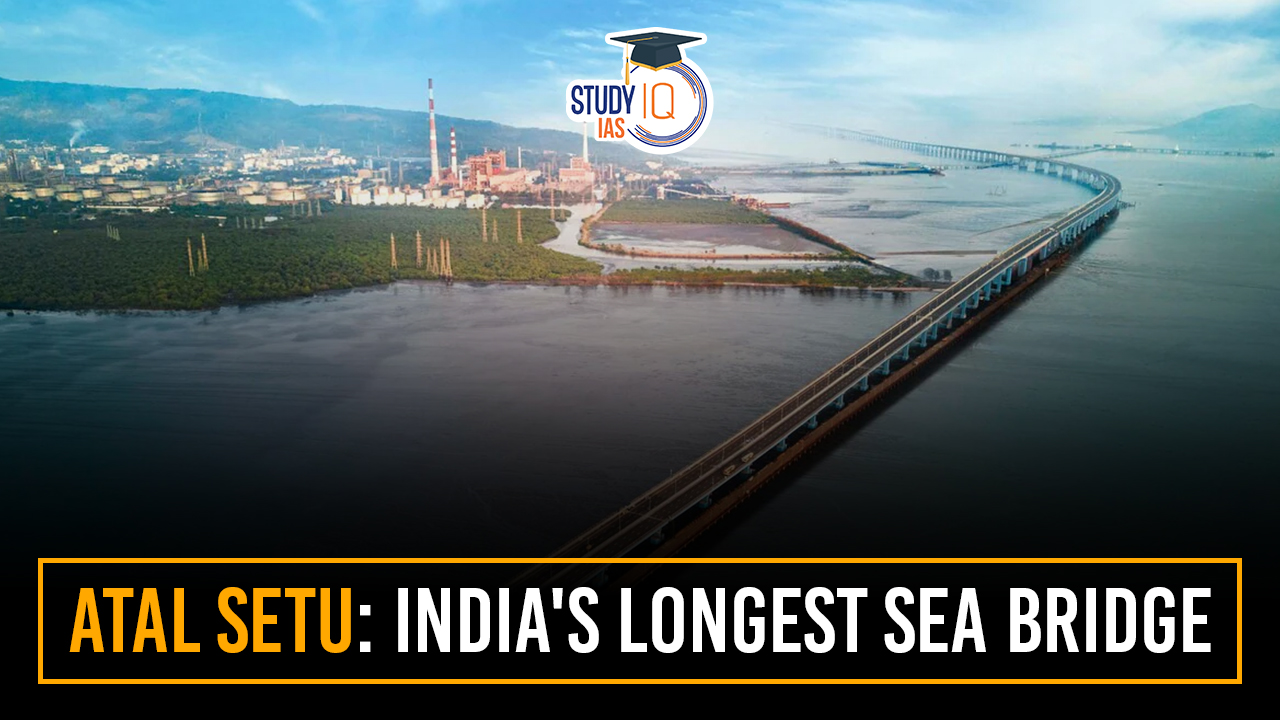Table of Contents
Atal Setu Bridge in Mumbai Recent Controversy
India’s recently opened Mumbai Trans Harbour Link (MTHL), also known as the Atal Bihari Vajpayee Sewri-Nhava Sheva Atal Setu, is under inspection after cracks emerged on an exit road near Navi Mumbai. The bridge, the longest sea bridge in the country, was inaugurated by Prime Minister Modi just a few months back.
Opposition leaders allege corruption due to the cracks on the new bridge. However, authorities clarified that the cracks are minor and limited to a connecting road/approach road, not the main bridge structure itself.
PM Modi Inaugurated Atal Setu Bridge in Mumbai
India’s longest sea bridge, Atal Setu Bridge, was inaugurated by Prime Minister Narendra Modi in Mumbai on January 12. Connecting Mumbai to Navi Mumbai, the 21.8 km Mumbai Trans Harbour Link, named Atal Bihari Vajpayee Sewri-Nhava Sheva Atal Setu, reduces travel time significantly. The bridge features a 16.5 km sea stretch and an additional 5.5 km on land.
PM Modi highlighted it as a symbol of a developed India, emphasizing connectivity, prosperity, and progress. The project aligns with the vision to enhance mobility and connect key locations like Mumbai and Navi Mumbai airports. The toll for travellers is ₹250 one-way.
Atal Setu Bridge Overview
| Atal Setu Bridge Overview | |
| Status | Longest and the longest sea bridge in India |
| Global Ranking | 12th longest sea bridge in the world |
| Budget Outlay | ₹17,840 crore |
| Foundation Stone Laid | December 2016 by the Prime Minister |
| Dimensions | 21.8 km six-lane bridge (16.5 km sea, 5.5 km land) |
| Expected Daily Traffic | Almost 70,000 vehicles |
| Expected Lifespan | 100 years |
| Connectivity | Faster access to Mumbai and Navi Mumbai Airports |
| Technology Features | All-weather design, lightning protection, noise barriers |
| Environmental Measures | Flamingo-protected area and Bhabha Atomic Research Centre |
| Travel Time Reduction | Mumbai to Pune, Goa, and South India |
| Fuel Cost Savings | Approximately ₹500 per journey |
| Toll Charges | ₹250 as a one-way toll for cars (half the standard toll) |
Key Features of Atal Setu
- Cost and Length: Atal Setu, constructed at a cost exceeding ₹17,840 crore, spans 21.8 kilometers, combining a 16.5 km stretch over the sea with approximately 5.5 km on solid ground.
- Connectivity: Strategically enhancing connectivity between Mumbai Port and Jawaharlal Nehru Port, the bridge facilitates faster access to Mumbai International Airport and Navi Mumbai International Airport.
- Reduced Travel Time: Geared towards significantly reducing travel time, Atal Setu aims to transform the current two-hour journey from Mumbai to Pune, Goa, and South India into a swift 15-20 minute commute.
- Historical Significance: Originally conceptualized six decades ago, Atal Setu fulfills its primary objective by linking Mumbai’s Sewri with Raigad’s Chirle, marking a historic milestone in India’s infrastructure development.
- Maximum Speed Limit: The Mumbai Trans Harbour Link sets a maximum speed limit of 100 kmph for four-wheelers, ensuring efficient and swift transportation.
Mumbai Trans Harbour Link (MTHL)
The Mumbai Trans Harbour Link is a significant infrastructure project in Mumbai, India. It is designed to connect the island city of Mumbai with the mainland at Navi Mumbai. Here are some key details about the project:
Length and Location
- The Mumbai Trans Harbour Link is designed to be a 22-kilometer long bridge and will be one of the longest sea bridges in India.
- It connects Sewri in South Mumbai to Chirle in Navi Mumbai, spanning across the Mumbai Bay.
Technologies Incorporated
- Reverse Circulation Drilling (RCD) Piling: RCD is an innovative technology used for the first time in India for pile foundation laying. It minimizes noise disturbances compared to traditional vertical drilling methods.
- Orthotropic Steel Deck (OSD) Bridge Girders: OSD is a construction method that combines strength and flexibility. This technology allows the bridge’s steel deck to withstand heavy loads, such as vehicles, while maintaining a lightweight structure.
- Open Road Tolling (ORT) System: MTHL became the first project in the country to adopt the ORT method of collecting tolls. This system allows toll collection without requiring vehicles to stop or slow down, enhancing efficiency.
Atal Setu Benefits
- Reduced Travel Time: According to a study conducted by the Mumbai Metropolitan Region Development Authority (MMRDA) and the Japan International Cooperation Agency (JICA), the MTHL is expected to bring down the average travel time between Sewri and Chirle from 61 minutes to less than 16 minutes.
- Increased Vehicle Usage: Close to 40,000 vehicles are expected to use the link every day in the opening year (2024).
- Economic Integration: The project is expected to facilitate greater economic integration of Navi Mumbai with Mumbai, with benefits extending to areas like Panvel, Alibaug, Pune, and Goa.
- Improved Connectivity: The bridge reduces the distance between Mumbai and Pune Expressway, enhancing overall connectivity in the region.
We’re now on WhatsApp. Click to Join
Atal Setu Bridge UPSC
Prime Minister Narendra Modi inaugurated the Atal Setu Bridge, India’s longest sea bridge, on January 12 in Mumbai. Part of the Mumbai Trans Harbour Link (MTHL), it spans 21.8 km, connecting Mumbai to Navi Mumbai and reducing travel time significantly. The bridge, with a 16.5 km sea stretch and 5.5 km on land, holds the 12th global rank for longest sea bridges. It aims to enhance connectivity, with an expected daily traffic of almost 70,000 vehicles and toll charges of ₹250 for a one-way journey.


 SSC MTS Salary 2025, Check Highest Salar...
SSC MTS Salary 2025, Check Highest Salar...
 F-35 Fighter Jet Stranded in Kerala: Dis...
F-35 Fighter Jet Stranded in Kerala: Dis...
 List of Awards and Honours Received by N...
List of Awards and Honours Received by N...





















